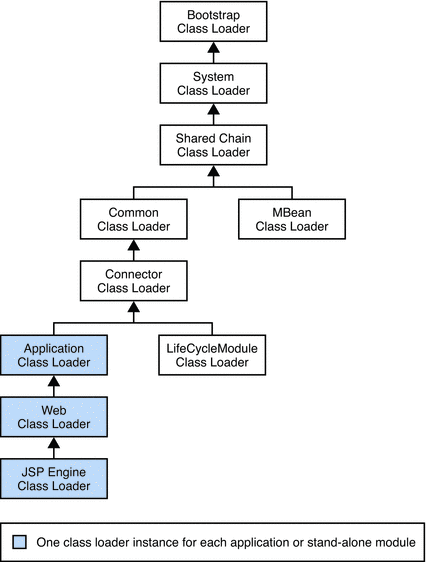Class loaders in the Application Server runtime follow a delegation hierarchy that is illustrated in the following figure and fully described inTable 2–1.
Figure 2–1 Class Loader Runtime Hierarchy

The following table describes the class loaders in the Application Server.
Table 2–1 Sun Java System Application Server Class Loaders
|
Class Loader |
Description |
|---|---|
|
The Bootstrap class loader loads the basic runtime classes provided by the JVM, plus any classes from JAR files present in the system extensions directory. It is parent to the System class loader. To add JAR files to the system extensions, directory, see Using the Java Optional Package Mechanism. |
|
|
The System class loader loads Application Server launch classes. It is parent to the Shared Chain class loader. It is created based on the system-classpath attribute of the java-config element in the domain.xml file. In the Admin Console, select the Application Server component, the JVM Settings tab, and the Path Settings tab, then edit the System Classpath field. See Using the System Class Loader and java-config in Sun Java System Application Server Platform Edition 9 Administration Reference. |
|
|
Shared Chain |
The Shared Chain class loader loads most of the core Application Server classes. It is parent to the MBean class loader and the Common class loader. Classes specified by the classpath-prefix and classpath-suffixattributes of the java-config element in the domain.xml file are added to this class loader. In the Admin Console, select the Application Server component, the JVM Settings tab, and the Path Settings tab, then edit the Classpath Prefix or Classpath Suffix field. The environment classpath is included if env-classpath-ignored="false" is set in the java-configelement. Use classpath-prefix to place libraries ahead of Application Server implementation classes in the shared chain. The classpath-prefix is ideal for placing development and diagnostic patches. Use classpath-suffix to place libraries after implementation classes in the shared chain. |
|
The MBean class loader loads the MBean implementation classes. See MBean Class Loading. |
|
|
The Common class loader loads classes in the domain-dir/lib/classes directory, followed by JAR files in thedomain-dir/lib directory. It is parent to the Connector class loader. No special classpath settings are required. The existence of these directories is optional; if they do not exist, the Common class loader is not created. See Using the Common Class Loader. |
|
|
The Connector class loader is a single class loader instance that loads individually deployed connector modules, which are shared across all applications. It is parent to the LifeCycleModule class loader and the Application class loader. |
|
|
The LifeCycleModule class loader is created once per lifecycle module. Each lifecycle-module element’sclasspath attribute is used to construct its own class loader. For more information on lifecycle modules, seeChapter 13, Developing Lifecycle Listeners. |
|
|
The Application class loader loads the classes in a specific enabled individually deployed module or Java EE application. One instance of this class loader is present in each class loader universe; see Class Loader Universes. The Application class loader is created with a list of URLs that point to the locations of the classes it needs to load. It is parent to the Web class loader. The Application class loader loads classes in the following order:
The location attribute points to domain-dir/applications/j2ee-apps/app-name or domain-dir/applications/j2ee-modules/module-name. The stubs directory is domain-dir/generated/ejb/j2ee-apps/app-name or domain-dir/generated/ejb/j2ee-modules/module-name. |
|
|
The Web class loader loads the servlets and other classes in a specific enabled web module or a Java EE application that contains a web module. This class loader is present in each class loader universe that contains a web module; see Class Loader Universes. One instance is created for each web module. The Web class loader is created with a list of URLs that point to the locations of the classes it needs to load. The classes it loads are in WEB-INF/classes or WEB-INF/lib/*.jar. It is parent to the JSP Engine class loader. |
|
|
The JSP Engine class loader loads compiled JSP classes of enabled JSP files. This class loader is present in each class loader universe that contains a JSP page; see Class Loader Universes. The JSP Engine class loader is created with a list of URLs that point to the locations of the classes it needs to load. |
Note that this is not a Java inheritance hierarchy, but a delegation hierarchy. In the delegation design, a class loader delegates classloading to its parent before attempting to load a class itself. A class loader parent can be either the System class loader or another custom class loader. If the parent class loader cannot load a class, the class loader attempts to load the class itself. In effect, a class loader is responsible for loading only the classes not available to the parent. Classes loaded by a class loader higher in the hierarchy cannot refer to classes available lower in the hierarchy.
The Java Servlet specification recommends that the Web class loader look in the local class loader before delegating to its parent. You can make the Web class loader follow the delegation inversion model in the Servlet specification by setting delegate="false" in the class-loader element of the sun-web.xml file. It is safe to do this only for a web module that does not interact with any other modules. For details, see class-loader in Sun Java System Application Server Platform Edition 9 Application Deployment Guide.
The default value is delegate="true", which causes the Web class loader to delegate in the same manner as the other class loaders. You must use delegate="true" for a web application that accesses EJB components or that acts as a web service client or endpoint. For details about sun-web.xml, see The sun-web.xml File in Sun Java System Application Server Platform Edition 9 Application Deployment Guide.
https://docs.oracle.com/cd/E19501-01/819-3659/beadf/index.html

微信公众号: 架构师日常笔记 欢迎关注!




